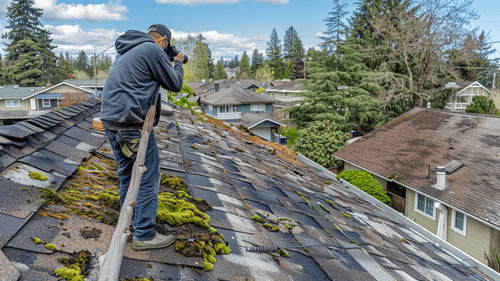Introduction: The Importance of Choosing the Right Roof Color
In the Texas heat, every decision about your home can make a difference—starting with your roof. Did you know the color of your roof could impact your home’s energy efficiency and cooling costs? It’s not just about looks; the right roof color can help reflect sunlight, reduce heat absorption, and keep your home cooler during those scorching Texas summers.
Cool roofs, specifically designed to reflect more sunlight and absorb less heat, are a game-changer for energy efficiency. But how do they work, and what makes them so effective at lowering energy bills in a climate as intense as Texas?
In this guide, we’ll break down how roof color choices influence your home’s temperature and energy use, uncover the science behind cool roofs, and share practical tips for selecting the perfect color that balances function and style. Ready to make a decision that keeps your home cooler and more energy-efficient in the Texas sun? Let’s dive in!
Exploring the Science Behind Cool Roofs
Cool roofs are designed to reflect more sunlight and absorb less heat compared to standard roofing materials. This is achieved through reflective paint, a sheet covering, or highly reflective tiles or shingles. The core principle of cool roofs is their ability to reflect the sun's energy away from the building, significantly reducing the amount of heat transferred inside. This reflection is directly linked to decreased energy consumption for cooling purposes.
The Department of Energy notes that white or specially coated roofing materials can reflect between 60-90% of sunlight, much higher than traditional materials, which typically reflect only 10-20%. This high reflectivity is crucial in reducing energy costs, especially during peak cooling periods. The less heat absorbed by the roof, the less heat that enters the building, thus reducing the workload on air conditioning systems.
Analyzing the Impact of Roof Color on Building Temperatures
The influence of roof color on a building's internal temperature is significant. Darker colors tend to absorb more heat, increasing indoor temperatures and necessitating more air conditioning. Conversely, lighter colors and reflective materials help maintain cooler building interiors, thus lowering cooling loads. This effect is supported by substantial data.
For example, simulations by the Florida Solar Energy Center demonstrate that reflective roof colors can reduce cooling loads by 10-60%, with the greatest reductions occurring in buildings with uninsulated roof systems. This data underscores the substantial impact roof color can have, particularly in regions experiencing prolonged high temperatures.
The distinction between insulated and uninsulated roof systems is also significant. While both benefit from reflective roofing, the effects are more pronounced in uninsulated systems where direct heat transfer is greater. This emphasizes the need to consider both insulation and roof color when optimizing for energy efficiency.
Cost-Benefit Analysis of Cool Roof Colors
When homeowners consider transitioning to a cool roof, they often evaluate the cost against the benefits. How substantial are the savings on cooling costs? The Department of Energy suggests that installing a cool roof can reduce cooling costs by up to 15%, a notable saving especially in warm climates.
Here’s a breakdown of potential savings:
- Immediate reduction in cooling needs: Less heat absorbed by the roof means air conditioning systems work less, immediately lowering energy bills.
- Extended lifespan of cooling equipment: A reduced workload can prolong the life of air conditioning systems, potentially saving on repairs and replacements.
- Increase in roof lifespan: Reflective roofs can also last longer than traditional roofs due to reduced heat damage.
Although the initial cost of a cool roof might be higher than traditional materials, the long-term benefits often outweigh the initial expense. Homeowners in hot climates will particularly benefit from the energy savings and enhanced comfort of a cooler indoor environment.
Practical Tips for Selecting the Right Roof Color
Selecting the right roof color for energy efficiency involves more than just choosing a light shade. Consider these factors:
- Local climate: Homeowners in hotter, sunnier climates will benefit most from highly reflective roof colors.
- Aesthetic and architectural style of the home: While functionality is crucial, the color should also complement the overall look of your home.
- Regulations and neighborhood codes: Some areas have regulations regarding roofing materials and colors.
Recommendations for homeowners in different climatic zones:
- Hot and sunny areas: Opt for white or light-colored roofs with high reflectivity.
- Cooler, less sunny areas: In these areas, the benefits of cool roofs diminish, but lighter colors can still assist with heat management during warmer months.
Balancing aesthetics and functionality is key. Here are some tips to achieve that:
- Consult with design professionals: They can help you choose a color that fits both your home’s style and energy-saving goals.
- Consider the visual impact: A reflective roof doesn't have to be white. Many roofing materials now offer good reflectivity in colors that suit different styles and preferences.
By considering these factors, homeowners can make informed decisions that result in both a beautiful and energy-efficient home. The right roof color not only enhances curb appeal but also significantly affects the home's energy consumption profile.
Conclusion: Reflecting on Roof Color Choices for Enhanced Home Efficiency
The exploration of cool roofs has revealed their significant potential in enhancing home energy efficiency and reducing cooling costs. By reflecting sunlight and minimizing heat absorption, cool roofs, particularly those in lighter shades or with reflective materials, effectively decrease indoor temperatures and the demand on air conditioning systems. This not only leads to immediate energy savings but also extends the lifespan of both the roofing and cooling equipment. Homeowners, especially in warmer climates, stand to benefit greatly from the reduced energy bills and increased comfort that a well-chosen roof color can provide.
As we've navigated through the science and practical considerations of selecting the right roof color, it's clear that the choice impacts your home's energy consumption and comfort significantly. Remember, the right roof color can transform your home into a bastion of efficiency and comfort, ensuring you're covered in style and sustainability. With this knowledge, homeowners are better equipped to make choices that align with both their style and energy-saving goals, fostering a harmonious balance between beauty and functionality. Selecting a roof color is a decision that embraces a smarter, more sustainable way of living.







